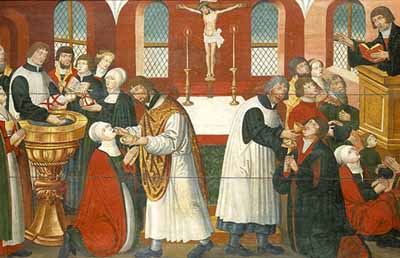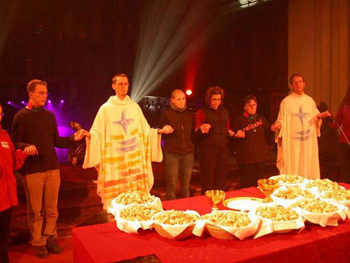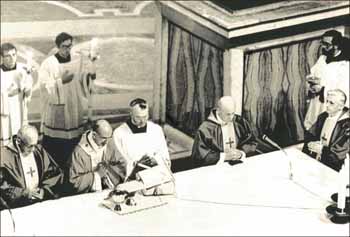About the Church
 |
 |
 |
 |
 |
 |
 |
The Holy Mass - Part II
From the Gregorian Sacramentary to the
Novus Ordo Missae
From the 6th century to the 15th, superfluous deletions, additions and substitutions were made in the Gregorian Sacramentary, lessening its purity and creating ambiguities, These changes were addressed by the Council of Florence in 1442.
An important item taken up by this Council was the Consecratory Formulae, which are said for the bread and wine to be transubstantiated into the true Body, Blood and Divinity of Our Lord. The Council set forth both formulae precisely as they were in the Gregorian Sacramentary and as they are in the present Tridentine Mass. (1)
The Protestant Revolt & the Council of Trent
A century later, the blasphemous Protestant Reformation was blazing. In Germany its leader was the arch-heretic Martin Luther (1483-1546), the Augustinian friar who rebelled against the Catholic Church. His Works abound with infamous statements against the Church, her holy Sacraments, and especially the Holy Mass. He is recorded as saying, "Once the Mass has been overthrown, I say we will have overthrown the whole of Popedom." (2)
Another comment revealing his deep hatred: The Mass is "the height of idolatry and impiety," an evil introduced by Satan: "It is indeed upon the Mass as on a rock that the whole Papal system is built, with its monasteries, its bishoprics, its collegiate churches, its altars, its ministries, its doctrine, i.e., with all its guts. All these cannot fail to crumble once their sacrilegious and abominable Mass falls." (3)
 Another insidious heretic raised his head in England, King Henry VIII (1491-1547), who made himself the head of the so-called Church of England and appointed the infamous Thomas Cranmer (1489-1556) as Archbishop of Canterbury.
Another insidious heretic raised his head in England, King Henry VIII (1491-1547), who made himself the head of the so-called Church of England and appointed the infamous Thomas Cranmer (1489-1556) as Archbishop of Canterbury.
As with Luther, a main goal of Cranmer was the destruction of the Mass. His blasphemous statements echoed those of Luther: "The roots of the weeds [that led to idolatry] is the popish doctrine of Transubstantiation, of the Real Presence of Christ's flesh and blood in the sacrament of the altar (as they call it)." (4) Or, "The popish Mass is detestable idolatry, utterly to be banished from all Christian congregations." (5)
A large body of the reforms that Cranmer made to do away with the "popish Mass" can be seen in the Novus Ordo Missae: change of the name to the Lord's Supper, celebration in the vernacular and audibly throughout, replacement of the altar with a table, elimination of sacrificial terminology, diminution of the distinction between priest and people, modification of the Consecratory Formulae, Communion given under both species, and Communion in the hand.
A response of the Church to this attack was the convoking of the Council of Trent in 1545, which only ended 18 years later in 1563. The Council of Trent, convoked in 25 sessions, was turned toward uprooting the heresies of Protestantism. Therefore, it dealt with the Sacraments, indulgences, feast days, the catechism, the Breviary and, most importantly, the Missale Romanum, which reaffirmed that same Gregorian Sacramentary of St. Gregory the Great.
De defectibus & Quo primum
The 22nd session was devoted entirely to the Holy Sacrifice of the Mass. The Decree De defectibus was a consequence of the Council following the same spirit, written after its closure by Pope St. Pius V. It was aimed to eliminate defects that could occur in the celebration of the Mass so that priests would always say Mass in the same manner. Some examples are: not to use defective bread or wine; to always keep the same form; to avoid any omission or alteration in the formulae, which would invalidate the consecration.
 Yet this last mentioned defect is precisely what happened with the changes made by the ICEL (International Committee for English in the Liturgy) in 1969 with the alteration of the Consecratory Formulae for transforming the wine into the Precious Blood by deleting the vitally important words 'Mysterium Fidei' and pro multis. In fact, the words "for all" instead of "for many" were deviations expressly condemned by the Council of Trent.
Yet this last mentioned defect is precisely what happened with the changes made by the ICEL (International Committee for English in the Liturgy) in 1969 with the alteration of the Consecratory Formulae for transforming the wine into the Precious Blood by deleting the vitally important words 'Mysterium Fidei' and pro multis. In fact, the words "for all" instead of "for many" were deviations expressly condemned by the Council of Trent.
Pope St. Pius V also issued the Bull Quo primum tempore dated July 14, 1570.
This Bull ordered the promulgation of the new Roman Missal and established it as the Mass for all future time. (6) The Tridentine Mass, as it came to be called, derived its name from the Council of Trent, Concilium Tridentinum, and, as already mentioned, reinforced the Gregorian Sacramentary of the late 6th century in the Ordinary of the Mass.
Is Quo primum still binding?
A controversy has risen over the status of Quo primum tempore. One party holds that by being declared ex cathedra, Quo primum tempore can never be revoked or modified, since St. Pius V infallibly defined that Quo primum cannot be reformed. This would impose a strict adherence to its contents beyond what is implied by a mere Papal Bull.
 Therefore, it is affirmed that Quo primum tempore is not merely an ecclesiastical law because the rite of the Mass codified in the Tridentine Missal is the received and approved rite of the Roman Church that has been handed down by the Holy Roman Church. This position is sustained by Raymond Taouk:
Therefore, it is affirmed that Quo primum tempore is not merely an ecclesiastical law because the rite of the Mass codified in the Tridentine Missal is the received and approved rite of the Roman Church that has been handed down by the Holy Roman Church. This position is sustained by Raymond Taouk:
"The status of Quo primum, therefore, pertains to Divine Law in so much as it codifies what is contained in Sacred Tradition. For this reason, it has the infallibility of the Ordinary Magisterium, indirectly, as it touches on the Church's teachings on the Sacrifice of the Mass and Real Presence protecting them from the innovations of heretics. Therefore, no pope can ever licitly abrogate Quo primum tempore without betraying the Deposit of Faith. Pope Paul VI, in introducing the Novus Ordo Missae, did not even attempt to abrogate Quo primum, Pope John Paul II has also recognized this fact." (7)
Another party sustains a different position. It does consider that Quo primum tempore can be reformed by another Pope. This position is sustained by Atila Guimaraes in his article entitled "Quo Primum vs. Novus Ordo," where he notes that while one Pope can reform the decision of previous Popes, this would not be applicable in the case of the introduction of the Novus Ordo Missae after Vatican II:
"This only applies to those reforms that do not change the substance of the sacraments and the Mass. However, Paul VI changed the substance of the Mass when he changed the formulae of the Canon from Latin to the vernacular, allowed different Canons to be said, hid the sacrificial character of the Mass, gave a different meaning to the Eucharist, and presented a Protestant interpretation to the whole of the Mass in opposition to what had been established by St. Pius V. Therefore, Paul VI frontally defied the sentence of St. Pius V, going far beyond the limits of his authority [for more on this topic, click here]."
Thus, one can consider that Paul VI, at the least, committed an illegitimate action, which favors Protestantism, when he promulgated the New Mass after Vatican II (8) with other disastrous consequences for the Holy Church and all the faithful.
Continued

An important item taken up by this Council was the Consecratory Formulae, which are said for the bread and wine to be transubstantiated into the true Body, Blood and Divinity of Our Lord. The Council set forth both formulae precisely as they were in the Gregorian Sacramentary and as they are in the present Tridentine Mass. (1)
The Protestant Revolt & the Council of Trent
A century later, the blasphemous Protestant Reformation was blazing. In Germany its leader was the arch-heretic Martin Luther (1483-1546), the Augustinian friar who rebelled against the Catholic Church. His Works abound with infamous statements against the Church, her holy Sacraments, and especially the Holy Mass. He is recorded as saying, "Once the Mass has been overthrown, I say we will have overthrown the whole of Popedom." (2)
Another comment revealing his deep hatred: The Mass is "the height of idolatry and impiety," an evil introduced by Satan: "It is indeed upon the Mass as on a rock that the whole Papal system is built, with its monasteries, its bishoprics, its collegiate churches, its altars, its ministries, its doctrine, i.e., with all its guts. All these cannot fail to crumble once their sacrilegious and abominable Mass falls." (3)

Luther and Hus giving communion of both species, inviting all the faithful to the 'table'
As with Luther, a main goal of Cranmer was the destruction of the Mass. His blasphemous statements echoed those of Luther: "The roots of the weeds [that led to idolatry] is the popish doctrine of Transubstantiation, of the Real Presence of Christ's flesh and blood in the sacrament of the altar (as they call it)." (4) Or, "The popish Mass is detestable idolatry, utterly to be banished from all Christian congregations." (5)
A large body of the reforms that Cranmer made to do away with the "popish Mass" can be seen in the Novus Ordo Missae: change of the name to the Lord's Supper, celebration in the vernacular and audibly throughout, replacement of the altar with a table, elimination of sacrificial terminology, diminution of the distinction between priest and people, modification of the Consecratory Formulae, Communion given under both species, and Communion in the hand.
A response of the Church to this attack was the convoking of the Council of Trent in 1545, which only ended 18 years later in 1563. The Council of Trent, convoked in 25 sessions, was turned toward uprooting the heresies of Protestantism. Therefore, it dealt with the Sacraments, indulgences, feast days, the catechism, the Breviary and, most importantly, the Missale Romanum, which reaffirmed that same Gregorian Sacramentary of St. Gregory the Great.
De defectibus & Quo primum
The 22nd session was devoted entirely to the Holy Sacrifice of the Mass. The Decree De defectibus was a consequence of the Council following the same spirit, written after its closure by Pope St. Pius V. It was aimed to eliminate defects that could occur in the celebration of the Mass so that priests would always say Mass in the same manner. Some examples are: not to use defective bread or wine; to always keep the same form; to avoid any omission or alteration in the formulae, which would invalidate the consecration.

The Novus Ordo Mass lends itself to every abuse
Pope St. Pius V also issued the Bull Quo primum tempore dated July 14, 1570.
This Bull ordered the promulgation of the new Roman Missal and established it as the Mass for all future time. (6) The Tridentine Mass, as it came to be called, derived its name from the Council of Trent, Concilium Tridentinum, and, as already mentioned, reinforced the Gregorian Sacramentary of the late 6th century in the Ordinary of the Mass.
Is Quo primum still binding?
A controversy has risen over the status of Quo primum tempore. One party holds that by being declared ex cathedra, Quo primum tempore can never be revoked or modified, since St. Pius V infallibly defined that Quo primum cannot be reformed. This would impose a strict adherence to its contents beyond what is implied by a mere Papal Bull.

Paul VI concelebrates the New Mass in 1977 in St. Peter's; Ratzinger is to the far right
"The status of Quo primum, therefore, pertains to Divine Law in so much as it codifies what is contained in Sacred Tradition. For this reason, it has the infallibility of the Ordinary Magisterium, indirectly, as it touches on the Church's teachings on the Sacrifice of the Mass and Real Presence protecting them from the innovations of heretics. Therefore, no pope can ever licitly abrogate Quo primum tempore without betraying the Deposit of Faith. Pope Paul VI, in introducing the Novus Ordo Missae, did not even attempt to abrogate Quo primum, Pope John Paul II has also recognized this fact." (7)
Another party sustains a different position. It does consider that Quo primum tempore can be reformed by another Pope. This position is sustained by Atila Guimaraes in his article entitled "Quo Primum vs. Novus Ordo," where he notes that while one Pope can reform the decision of previous Popes, this would not be applicable in the case of the introduction of the Novus Ordo Missae after Vatican II:
"This only applies to those reforms that do not change the substance of the sacraments and the Mass. However, Paul VI changed the substance of the Mass when he changed the formulae of the Canon from Latin to the vernacular, allowed different Canons to be said, hid the sacrificial character of the Mass, gave a different meaning to the Eucharist, and presented a Protestant interpretation to the whole of the Mass in opposition to what had been established by St. Pius V. Therefore, Paul VI frontally defied the sentence of St. Pius V, going far beyond the limits of his authority [for more on this topic, click here]."
Thus, one can consider that Paul VI, at the least, committed an illegitimate action, which favors Protestantism, when he promulgated the New Mass after Vatican II (8) with other disastrous consequences for the Holy Church and all the faithful.
Continued
- Denzinger, 715
- Works, vol. 15, p. 774. apud M. Powicke, The Reformation in England (Oxford, 1953), p. 285
- Works, "Against Henry, King of England: 1522," vol. 10, s. II, apud ibid. p. 220.
- Thomas Cramner, Archbishop Cranmer on the True and Catholic Doctrine and the Use of the Sacrament of the Lord's Supper, London: Protestant Reformation Society, 1907, p. xxiv
- Ibid., p. 244
- Pope Pius V made the new missal obligatory for all the churches of the Roman rite, except for the local churches having a particular rite that is at least 200 years old. This eliminated all the local liturgies that had emerged from the 14th century on when the ideas of nascent Protestantism were spreading.
- Raymond Taouk "Is Quo Primum still binding," Catholic apologetics Information online
- For a profound understanding of the horror of Vatican Council II, see the Collection Eli, Eli, Lamma Sabacthani? of Atila Guimaraes, an 11 volume work (9 already printed) that stand alone above all that has been written about Vatican II.

Posted February 13, 2014











